Digestive system
The digestive system is made up of the gastrointestinal (GI) tract—also called the digestive tract—and the liver, pancreas, and gallbladder. The GI tract is a series of hollow organs joined in a long, twisting tube from the mouth to the anus. The hollow organs that make up the GI tract are the mouth, esophagus, stomach, small intestine, large intestine—which includes the rectum—and anus. Food enters the mouth and passes to the anus through the hollow organs of the GI tract. The liver, pancreas, and gallbladder are the solid organs of the digestive system. The digestive system helps the body digest food.
The diagram shows the main parts of the digestive system including the areas most likely to be affected by CD or UC.

Bacteria in the GI tract, also called gut flora or microbiome, help with digestion. Parts of the nervous and circulatory systems also play roles in the digestive process. Together, a combination of nerves, hormones, bacteria, blood, and the organs of the digestive system completes the complex task of digesting the foods and liquids a person consumes each day.
IMPORTANT POINTS
-
Digestion is important for breaking down food into nutrients, which the body uses for energy, growth, and cell repair
-
Digestion works by moving food through the gastrointestinal (GI) tract
-
Digestion begins in the mouth with chewing and ends in the small intestine
-
As food passes through the GI tract, it mixes with digestive juices, causing large molecules of food to break down into smaller molecules. The body then absorbs these smaller molecules through the walls of the small intestine into the bloodstream, which delivers them to the rest of the body
-
Waste products of digestion pass through the large intestine and out of the body as a solid matter called stool
-
Digestive juices contain enzymes that break food down into different nutrients
-
The small intestine absorbs most digested food molecules, as well as water and minerals, and passes them on to other parts of the body for storage or further chemical change. Hormone and nerve regulators control the digestive process









